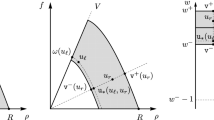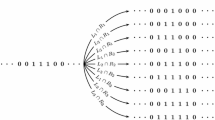Abstract
Our results concern long time limit properties of a deterministic dynamics that is common for a wide class of processes that have been studied so far during at least last two decades. The most widely known process from this class is a cellular automaton that acquired number 184 in the classification of S. Wolfram. This CA 184 is being intensively used to model vehicular traffic. However, our results are mainly derived with help of another process that offers a helpful insight into the studied dynamics, it is a so-called Ballistic Annihilation Model (abbreviated by BA). BA is a model for chemical reaction A+B → inert. In BA, A and B-type particles move in opposite directions with velocities 1 and -1, respectively, and annihilate upon collisions. Certain results concerning BA and CA 184 are also formulated in terms of another process known as a Model of Surface Growth (SG, for short); the surface shape in this process behaves as the integrated profile of particle distribution in CA 184.
Our results are as follows. First, we characterize the invariant measures of the dynamics in interest. The bulk of our effort is devoted to the characterization of those of them that are not translation invariant; we call them phase separating invariant measures. In the case of BA, such measures are concentrated on the configurations consisting of two converging infinite blocks of (not necessarily adjacent) particles. In the case of CA 184, a phase separating measure describes the transition from free traffic phase to jammed phase. We also analyze domains of attraction of invariant measures and rates of convergence to them. This analysis then allows us to express the long time limit of particle current in CA 184 as a function of certain characteristics of its initial distribution, when it is translation invariant. This expression has been used in a companion paper (V. Belitsky, J. Krug, E. J. Neves and G. Schütz, A cellular automaton model for two-lane traffic, J. Stat. phys.103(5/6):945--971 (2001)) to show the enhancement of cars’ current caused by the possibility of lane changes in a model of traffic on a two-lane highway that was created by putting two CA 184’s in parallel. Our other results concern hydrodynamic limits of BA and CA 184. We prove that if the integrated profile of initial particle configuration of BA or CA 184 converges, as n → ∞, to some stochastic process W(x), x ∈ R, when being re-scaled by n -1 along x-axis and by c n -1 along y-axis for some sequence c n , then the integrated profile of particle configuration at time n under the same re-scaling, will converge, as time → ∞, to the local moving minimum of the process W(·), that is, to the process W min(·) defined by W min(x):=min{W(y) :x-1≤ y≤ x+1}. This hydrodynamic limit is then interpreted in terms of the limiting shape of surface in SG.
Similar content being viewed by others
References
V. Belitsky P. A. Ferrari (1995) ArticleTitleBallistic annihilation and deterministic surface growth J. Stat. Phys. 80 IssueID(3/4) 517–543
V. Belitsky J. Krug E. J. Neves G. Schütz (2001) ArticleTitleA cellular automaton model for two-lane traffic J. Stat. Phys. 103 IssueID(5/6) 945–971
P. Billingsley, Convergence of Probability Measures Wiley Series in Probability and Mathematical Statistics (John Wiley & Sons, 1968).
E. Ben-Naim S. Redner F. Leyvraz (1993) ArticleTitleDecay kinetics of ballistic annihilation Phys. Rev. Lett. 70 1890–1893
U. Bertocci, Surf. Sci. 15:296 (1969).
M. S. Capcarrere M. Sipper M. Tomassini (1996) ArticleTitleTwo-state, r=1 cellular automaton that classifies density Phys. Rev. Lett. 77 IssueID24 4969–4971
Y. Elskens H. L. Frisch (1985) ArticleTitleAnnihilation kinetics in the one-dimensional ideal gas Phys. Rev. A 31 6
A. Ermakov B. Tóth W. Werner (1981) ArticleTitleOn some annihilating and coalescing systems J. Stat. Phys. 91 IssueID5/6 845–870
P. A. Ferrari, Shocks in the Burgers equation and the asymmetric simple exclusion process. in Automata Networks, Dynamical Systems and Statistical Physics, E. Goles, S. Martinez, eds. Kluwer Math. and its Appl. 25–64 (1992).
P. A. Ferrari K. Ravishankar (1992) ArticleTitleShocks in asymmetric exclusion automata Ann. of Appl. Prob. 2 IssueID4 928–941
W. Feller, Introduction to the Probability Theory and Its Applications, Vol. I (Wiley P, 1964).
L. Gray D. Griffeath (2001) ArticleTitleThe ergodic theory of traffic jams J. Stat. Phys. 105 IssueID3/4 413–452 Occurrence Handle10.1023/A:1012202706850 Occurrence Handle1048.90066
R. Fisch (1992) ArticleTitleClustering in the one-dimensional three-color cyclic cellular automaton Ann. Prob. 20 IssueID3 1528–1548
C. Kipnis C. Landim (1999) Scaling limits of interacting particle systems. series Fundamental Principles of Mathematical Sciences, Vol. 320 Springer-Verlag Berlin
P. L. Krapivsky F. Leyvraz S. Redner (1995) ArticleTitleBallistic Annihilation kinetics: The case of discrete velocity distribution Phys. Rev. E51 IssueID5 3977–3987
J. Krug H. Spohn (1988) ArticleTitleUniversality classes for deterministic surface growth Phys. Rev. A 38 4271–4283
J. Krug H. Spohn (1989) ArticleTitleAnomalous fluctuations in the driven and damped sine–Gordon chain Europhys. Lett. 8 IssueID3 219–224
T. M. Liggett (1976) ArticleTitleCoupling the simple exclusion process Anna. Prob. 4 IssueID3 339–356
T. Nagatani (1995) ArticleTitleCreation and annihilation of traffic jams in a stochastic asymmetric exclusion model with open boundaries: a computer simulation J. Phys. A: Math. Gen. 28 7079–7088
K. Nagel (1996) ArticleTitleParticle hopping models and traffic flow theory Phys. Rev. E 53 IssueID5 4655–4672
S. Wolfram (1983) ArticleTitleStatistical mechanics of cellular automata Rev. Mod. Phys. 55 601
S. Wolfram, Theory and Applications of Cellular Automata (World Scientific, Singapore, 1986)
H. Yaguchi (1986) ArticleTitleStationary measures for an exclusion process on one-dimensional lattices with infinitely many hopping sites Hiroshima Math. J. 16 449–475
Author information
Authors and Affiliations
Corresponding author
Rights and permissions
About this article
Cite this article
Belitsky, V., Ferrari, P.A. Invariant Measures and Convergence Properties for Cellular Automaton 184 and Related Processes. J Stat Phys 118, 589–623 (2005). https://doi.org/10.1007/s10955-004-8822-4
Received:
Accepted:
Issue Date:
DOI: https://doi.org/10.1007/s10955-004-8822-4




